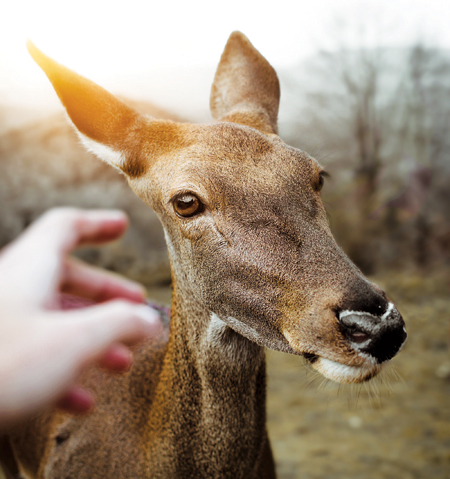A WHITETAIL CROSSING – Life In The Outdoors

I was driving on a highway through a woodland one cloudy, cold winter day recently. Trees and brush lined the road. It was a quiet road, no critters, not even a single bird. Then, suddenly, a deer bounded out of the cover ahead and across the road in front of me. It was a whitetail deer; its tail waving like a flag.
Though the tail of a whitetail appears to be all white, it isn’t. It is dark on top and white underneath and on the sides and the tip. That is enough, however to give this animal its name, whitetail deer.
I’m always pleased, thrilled even, to see a whitetail deer. Yet they are the most numerous, the most widespread deer of North America. Their range extends as far north in Canada as there are trees, south into Florida and the Gulf of Mexico and into Central Mexico and from the Atlantic Coast to the Pacific. There are few places in North America where there aren’t any whitetail deer. Curiously, in spite of their wide distribution, whitetail deer were originally called Virginia deer.
A mature buck whitetail is two and a half to three feet tall at the shoulder and an exceptionally big one can weigh nearly four hundred pounds, though two hundred to two fifty is more the norm. Does max out at two hundred fifty pounds, according to my reference books. I never weighed a whitetail, or any other deer.
Whitetails were numerous in pioneer days. Like the bison or American buffalo, however, they were killed in large numbers, shipped by railroad and sold in markets in East Coast cities. I never saw a whitetail in northern Iowa where I grew up when I was a young boy, but I occasionally heard old time hunters talk about how they used to hunt deer.
I don’t remember how old I was but I remember the first time I saw a wild deer but when I did there were laws prescribing hunting seasons. I was walking in a woods, alone, looking for birds and whatever other wildlife I might see and suddenly there was a deer before me, standing on the other side of an opening in the woods.
Now it is not rare to see a deer. I see them commonly when I’m out, driving or walking, usually one, sometimes two, sometimes a buck, sometimes a doe with one or two fawns. Sadly, I often see one at the side of the road, dead.
We have a small apple tree at the edge of our lawn and when the apples are ripe and falling I often seen several deer there, under the apple tree, particularly at night, feeding on the apples that have fallen.
Whitetail deer are browsers. They eat almost any fruit they can get. They eat acorns and other nuts, twigs, grass, mushrooms and other fungi.
While often seen singly, as the one I was saw crossing the highway was, or in pairs, a buck and doe during mating season or a doe with fawns, whitetails do gather in herds in winter and not just under our apple tree. I knew a place in north-central Indiana where deer gathered every year when snow covered the ground. There, when the weather was wintry and snow was deep, I saw herds of twenty-five, thirty, once even forty deer.
Deer in such numbers can do considerable damage, particularly to young trees and shrubs. To prevent deer becoming too numerous and causing such damage in State Parks in Indiana there are now deer hunts in the Parks. They occur on designated weekends and on those weekends only deer hunters, park employees and Conservation Officers are permitted in the parks.
But it isn’t necessary to go to a State Park to see whitetail deer in Indiana. Just go cruising on the roads.
- Birds As Weather Forecasters – Life In The Outdoors - December 17, 2021
- Rare Bird Spotted In Indiana – Life In The Outdoors - October 8, 2021
- MY EXPERIENCE WITH DEER – Life In The Outdoors - July 30, 2021


